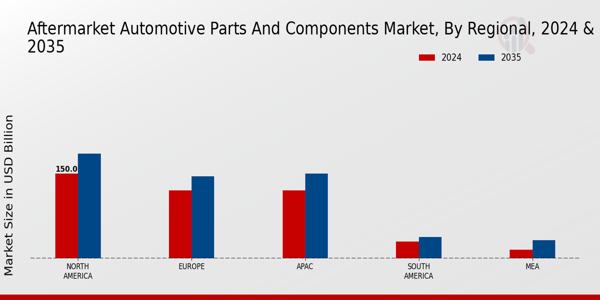Aftermarket Automotive Parts Component Market Summary
As per MRFR analysis, the Automotive Parts and Components Aftermarket Size was estimated at 435.78 USD Billion in 2024. The Automotive Parts and Components Aftermarket industry is projected to grow from 445.11 USD Billion in 2025 to 550.07 USD Billion by 2035, exhibiting a compound annual growth rate (CAGR) of 2.14 during the forecast period 2025 - 2035.
Key Market Trends & Highlights
The Automotive Parts and Components Aftermarket is experiencing robust growth driven by evolving consumer preferences and technological advancements.
- E-commerce growth is reshaping the distribution landscape, particularly in North America, where online sales of automotive parts are surging.
- Sustainability focus is becoming increasingly prominent, with consumers gravitating towards eco-friendly automotive products across both North America and Asia-Pacific.
- Technological advancements in automotive parts are enhancing performance and safety, particularly in the engine parts segment, which remains the largest.
- The rising consumer preference for DIY repairs and the increasing vehicle age are significant drivers propelling growth in the aftermarket, especially in the brake parts and two wheelers segments.
Market Size & Forecast
| 2024 Market Size | 435.78 (USD Billion) |
| 2035 Market Size | 550.07 (USD Billion) |
| CAGR (2025 - 2035) | 2.14% |
Major Players
Bosch (DE), Denso (JP), Magna International (CA), Valeo (FR), Aisin Seiki (JP), ZF Friedrichshafen (DE), Continental (DE), Delphi Technologies (GB), Tenneco (US)


















Leave a Comment